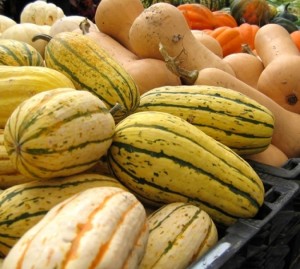Move Over, Pumpkin: A Guide To Cooking Winter Squash

Each fall, one squash in particular seems to dominate most kitchens: the pumpkin. It makes sense why we’ve placed so much emphasis on the pumpkin – and not just because of its association with Halloween. Pumpkins are not only good for you, but their general flavor lends them perfectly to a number of different recipes and cooking styles. Yet, fall is so much more than just the great and mighty pumpkin, as there is a bounty of squashes worth serving up. So, if you’re already a master at pumpkin, consider these tips for cooking squash all autumn long:
Know your squash
Unlike some fruits or vegetables that only grow once a year, there are actually two types of squash: summer and winter. As The Kitchn noted, there are 11 basic kinds of winter squash. The most common tasty varieties include:
- Spaghetti squash: Despite its name, this squash – with its cylinder-like shape – has a mild, decidedly un-sweet flavor.
- Butternut squash: An especially sweet squash, butternut is used in a number of different dishes, and it’s most often roasted or sauteed.
- Acorn squash: Though not as sweet as butternut, acorn squash also has a slightly nutty aftertaste, and some people even eat the skin.
- Hubbard squash: In many ways, the Hubbard tastes similar to pumpkin, In fact, it even makes great pie filling.
- Banana squash: This specific squash has both a sweet, slightly earthy taste, and is often used in place of butternut squash.

Peeling the easy way
For many chefs, peeling squash – or almost any fruit or veggie for that matter – can be a trying ordeal. Given the unique size and density of most squash, it’s easy to make a mistake during the peeling process, and that can lead to a nasty little accident. While there are several techniques, Skinny Taste seems to have found a nearly full-proof method for peeling winter squash.
With a fork, place a series of holes all over the squash, including the very top and bottom sections. Then, microwave the squash for two to four minutes; if your squash is larger, it may needed some added time. Finally, once the squash has cooled down for a few minutes, you can then begin to cut and peel. Though the microwave will have softened the skin, thus making it easier to manipulate, it’s important you still take your time and exercise caution to avoid injury.
Get cooking
There are a few different ways to actually cook and prepare squash. These techniques including baking, boiling, roasting and sauteing. No matter what technique you choose, it’s important to be aware of a few things. For one, not every squash needs to be peeled before cooking; however, you want to remove the seeds as these can interfere with the final flavor. For most small varieties of quash, you can simply chop the top off and then scoop out any seeds. Finally, you should always pay attention to how a squash is cooking to prevent over-baking. One way to check the doneness of squash is by sticking a fork inside; it should feel somewhat tender.






I see that the spaghetti squash should be poked holes into gourd via greatist. This will allow steam to come out from the spaghetti squash when it’s cooking and will prevent it from exploding inside the microwave.